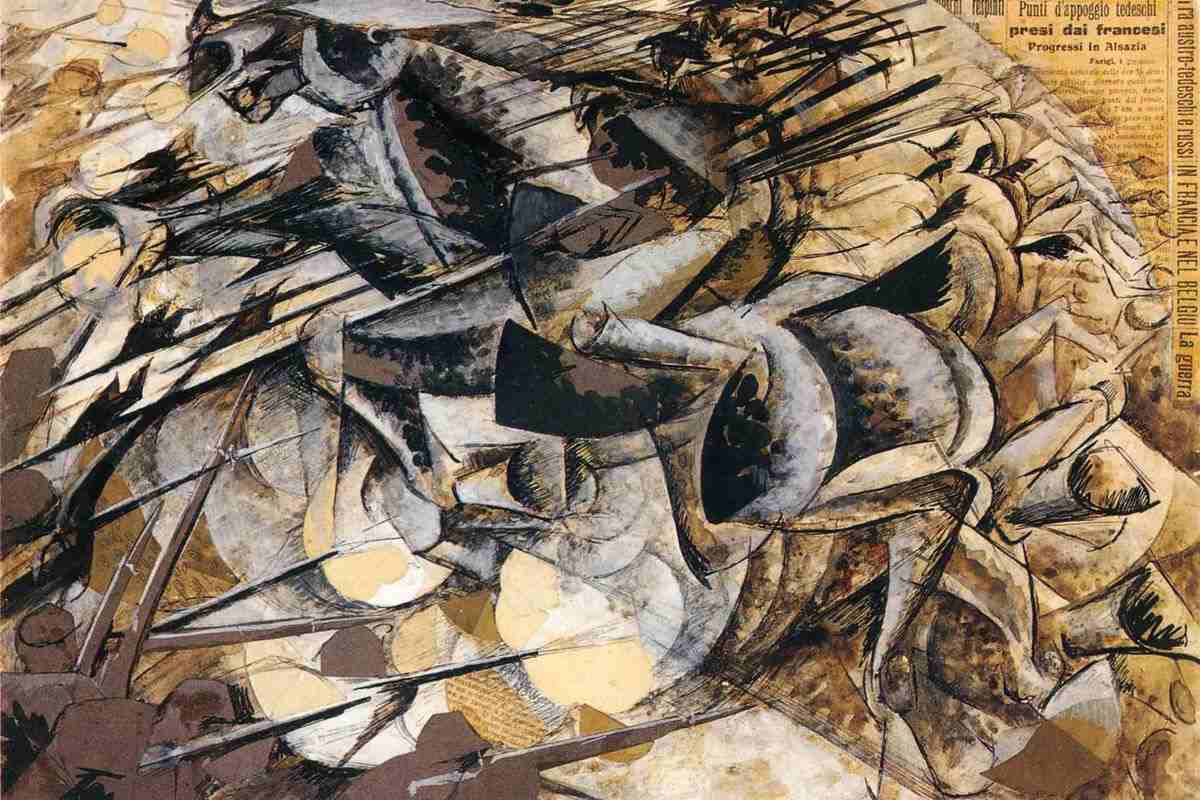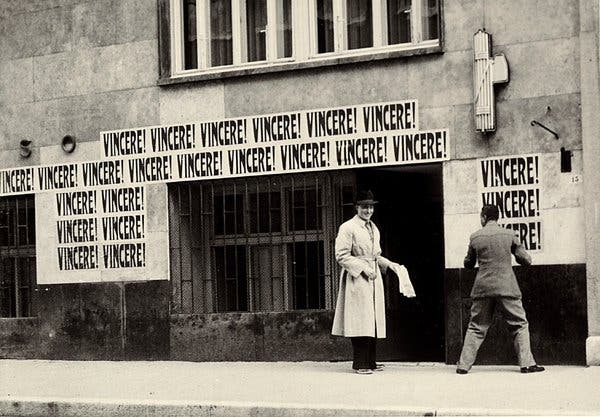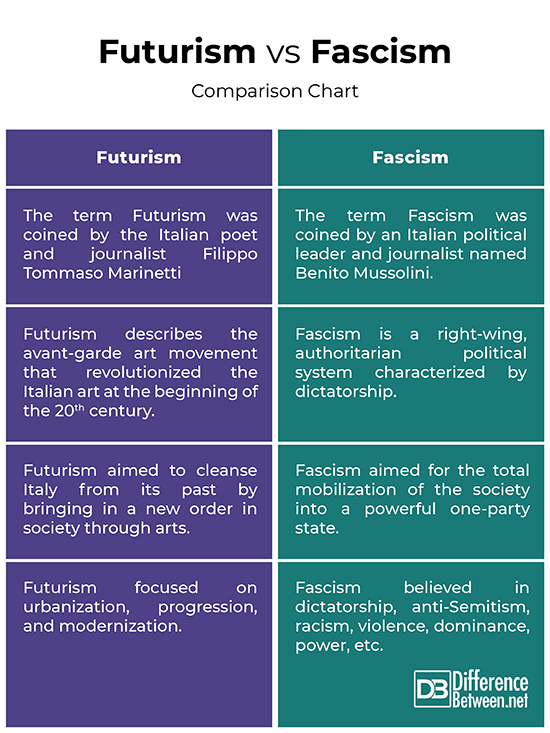Difference Between Futurism and Fascism
Italy had been scarred with some regrettable political records in the 20th century that the nation was not so proud of. Post World War I, Italy was the first country where a party of right-wing ultra-nationalists gained power and abolished democracy while aiming at creating a one-party state. At the end of the century, questions were raised on the nation’s destiny in an era of political disturbances produced by modernization.

What is Futurism?
Futurism describes the avant-garde art movement that revolutionized the Italian art at the beginning of the 20th century, which focused on the dynamism, progress, and modernity of the future world. Contrary to the ancient belief that focused on traditional ideologies and philosophies, futurism emphasized on the significance of the future, particularly as it relates to the modernization of the machine age and all that come with it – technology, industry, machines, trains, and speed.
Futurism focused on urbanization and progression, and the movement actively shunned past traditions. Futurism aimed at bringing in a new order by destroying past culture and traditions. Futurists were a group of people in the early 20th century wanted to bring a change in society through arts.
The Futurist movement can be traced back to a document named Manifesto del Futurismo written by the Italian poet Filippo Tommaso Marinetti in 1909. Marinetti coined the term “Futurism” to portray his goal of bringing in change and innovation in culture and society, and stepping into the future.

What is Fascism then?
Fascism is a right-wing, authoritarian political system characterized by dictatorship. It is a political ideology and movement whose fundamental core is a form of populist ultra-nationalism.
Many scholars still believe that the nature of fascism is complicated, vague and open to many different interpretations, but the true meaning of the word “Fascism” is still a question. Fascism actually comes from the Italian word “fascio,” which means a bundle or sheaf.
It had long been used as a political symbol in Europe. The late 19th-century Italian revolutionaries used this symbol to signify their commitment and loyalty to each other and their movement.
Italian fascism was outgrown after the betrayal of the uprising of the Italian proletariat by the reformists. An Italian political leader and journalist named Benito Mussolini, who ruled Italy from 1925 to 1945, founded the National Fascist Party and coined the term “fascism” in 1919 to dictate its political movement. In 1922, he became the prime minister of Italy and rose to power. He was killed by his own people in the final days of the World War II on April 28, 1945.
Difference between Futurism and Fascism
History of Futurism and Fascism
– The term “Futurism” was coined by the Italian poet and journalist Filippo Tommaso Marinetti who wrote a document named “Manifesto del Futurismo” in 1909. He published his manifesto on the front page of the national daily in France Le Figaro, through which he aimed to transform the Italian culture through arts. The term “Fascism”, on the other hand, was coined in 1919 by an Italian political leader and journalist named Benito Mussolini, who ruled Italy from 1925 to 1945, and founded the National Fascist Party to dictate its political movement. In 1945, he was killed by his own people.
Meaning of Futurism and Fascism
– The word “Fascism” actually comes from the Italian word “fascio,” which means a bundle or sheaf. It had long been used as a political symbol in Europe. The late 19th-century Italian revolutionaries used this symbol to signify their commitment and loyalty to each other and their movement. Fascism is a right-wing, authoritarian political system characterized by dictatorship.
Futurism, on the other hand, describes the avant-garde art movement that revolutionized the Italian art at the beginning of the 20th century. Futurism focused on urbanization and progression, and the movement actively shunned past traditions.
Ideology of Futurism and Fascism
– Italian Futurists led by Filippo Tommaso Marinetti were visionaries who thought of bringing in a new order by destroying past culture and traditions. They were a group of people in the early 20th century who wanted to bring in a change in society through arts. They were motivated by change and progression in regards to technology, industry, machines, trains, youth, and speed.
Italian Fascists, on the other hand, were ultra-nationalists who believed in dictatorship and absolute control of a nation and its economy. The fascists were commonly associated with German Nazi and Italian regimes, and wanted to expand Italian territories by taking advantage of people’s anger or sense of victimhood.
Futurism vs. Fascism: Comparison Chart

Summary
Although Futurism has been recognized as one of the most significant and influential avant-garde movements in the history of 20th century art, its political image has suffered from the supposed friendship between Filippo Tommaso Marinetti and Benito Mussolini. Futurism, for more than three decades, ranged from poetry to cooking, painting, politics, with original contributions in architecture, dance, theater, design and fashion. To understand Futurism in its entirety is to understand life in the 20th century Europe. The classical Fascism is the Fascism of Benito Mussolini, who founded the National Fascist Party and coined the term “fascism” in 1919, and finally ruled Italy from 1925to 1945, until he died by the hands of their own people. Ask any average person what comes to mind when head the word Fascism and the immediate answer would be dictatorship, racism, right wing, etc.
- Difference Between Caucus and Primary - June 18, 2024
- Difference Between PPO and POS - May 30, 2024
- Difference Between RFID and NFC - May 28, 2024
Search DifferenceBetween.net :
Leave a Response
References :
[0]Gentile, Emilio. The Struggle for Modernity: Nationalism, Futurism, and Fascism. Connecticut, United States: Greenwood Publishing Group, 2003. Print
[1]Daly, Selena. Italian Futurism and the First World War. Toronto, Canada: University of Toronto Press, 2016. Print
[2]Trotsky, Leon. Fascism: What it is and how to Fight it. New Delhi, India: Aakar Books, 2005. Print
[3]Goldberg, Jonah. Liberal Fascism: The Secret History of the Left from Mussolini to the Politics of Meaning. London, England: Penguin UK, 2009. Print
[4]London, John. One Hundred Years of Futurism: Aesthetics, Politics and Performance. Bristol, United Kingdom: Intellect Books, 2018. Print
[5]Berghaus, Gunter. Futurism and Politics: Between Anarchist Rebellion and Fascist Reaction, 1909-1944. New York, United States: Berghahn Books, 1996. Print
[6]Image credit: https://d16kd6gzalkogb.cloudfront.net/magazine_images/Umberto-Boccioni-The-Charge-of-the-Lancers-1915-via-pinterest-com.jpg
[7]Image credit: https://static01.nyt.com/images/2018/09/23/books/23Stille/23Stille-articleLarge.jpg?quality=75&auto=webp&disable=upscale
